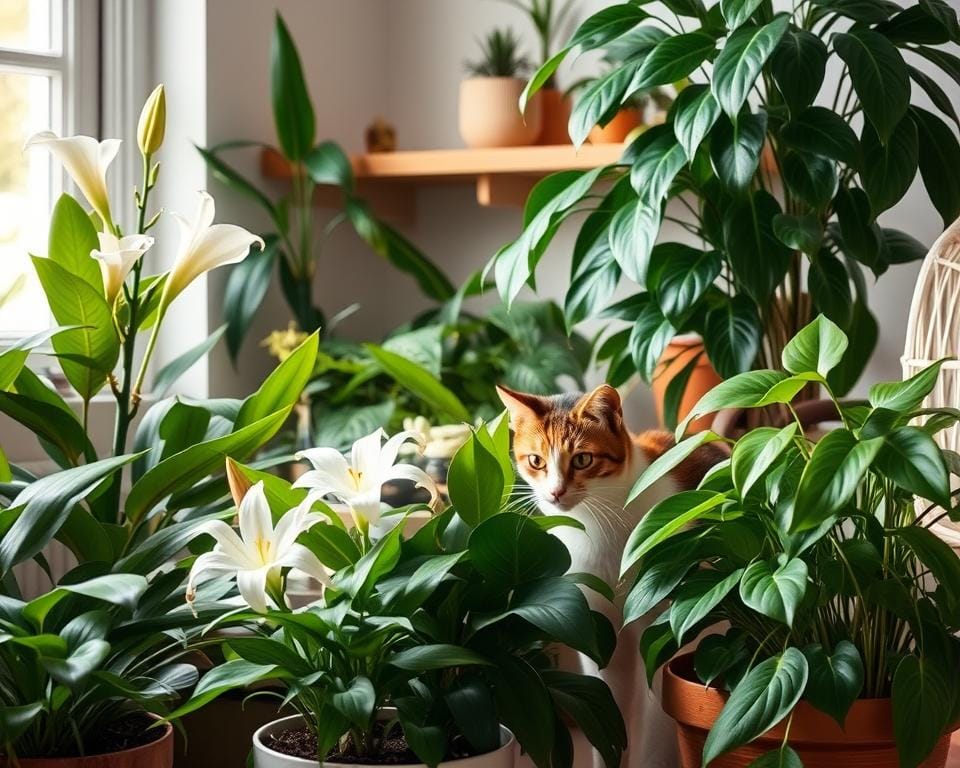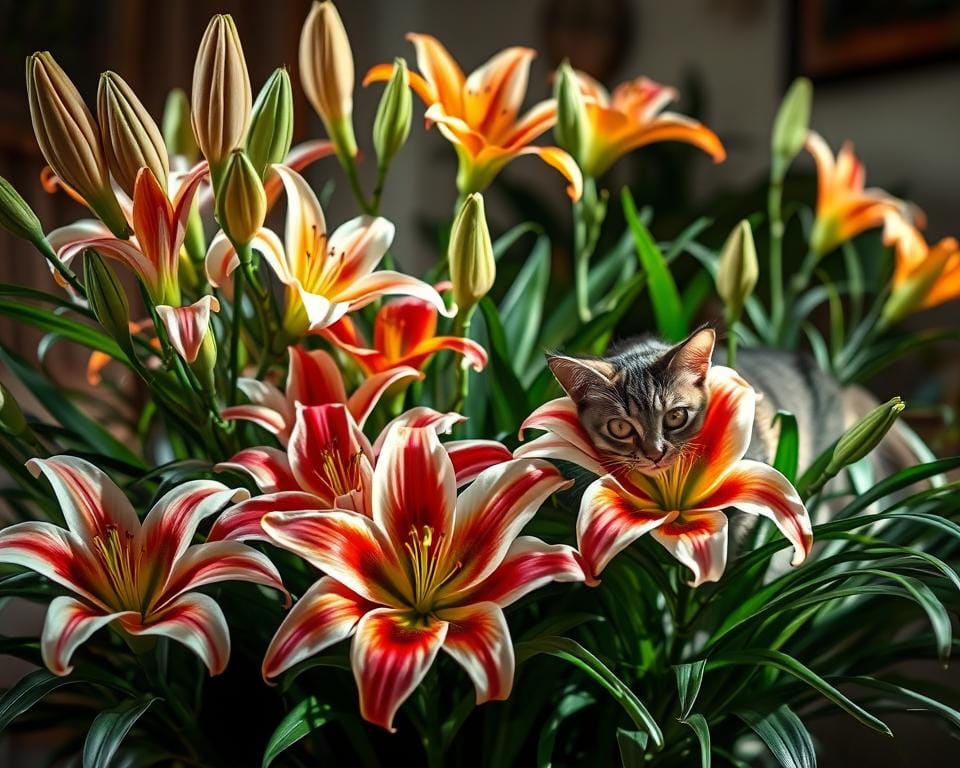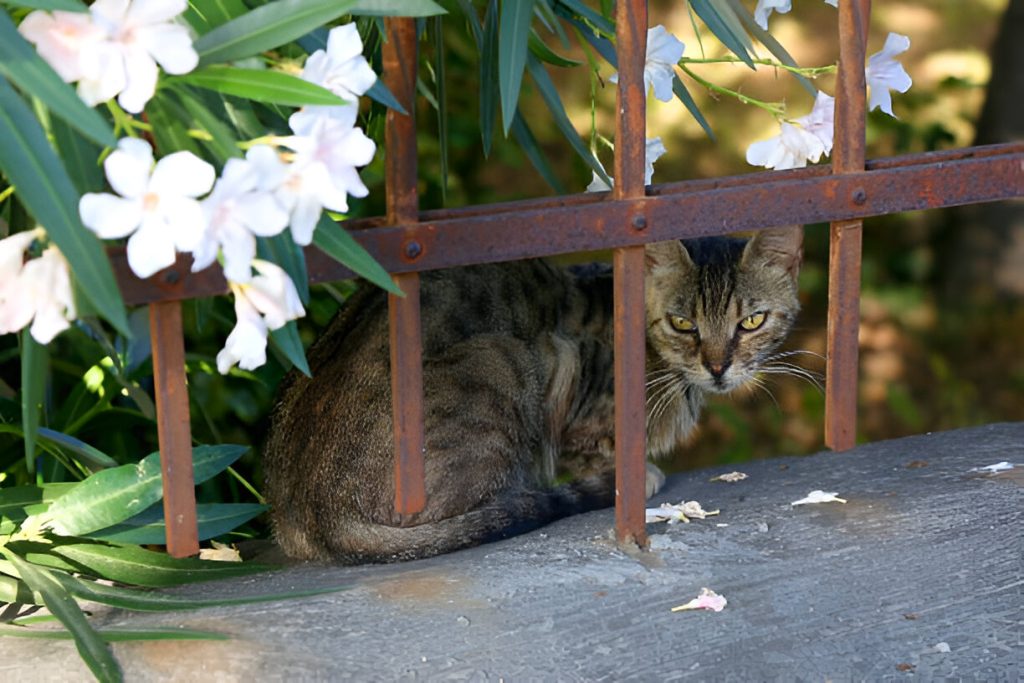As a cat parent, the thought of your feline friend eating a household plant can be scary. Many indoor plants clean the air and help reduce stress. But, some plants can be very harmful to your cat’s health. These plants have toxins that can cause serious health problems, like organ failure, seizures, or even death.
It’s important to learn about these dangers. You should also take steps to make your home safe for your cat.
Key Takeaways
- Certain indoor plants, such as lilies, sago palms, and Monstera deliciosa, are highly toxic to cats and can cause severe illness or even death if ingested.
- Symptoms of plant poisoning in cats can include vomiting, diarrhea, lethargy, and neurological issues, requiring immediate veterinary attention.
- Identifying and removing potentially dangerous plants from your home is essential to keeping your feline friend safe.
- Consulting with your veterinarian or a professional can help you navigate pet-safe plant choices and create a harmonious, cat-friendly indoor space.
- Ongoing vigilance and proactive plant management are key to ensuring your cat’s well-being in a green, flourishing home.
Introduction: The Hidden Dangers of Common Houseplants
As a pet owner, knowing the dangers in your home is key. Many common household plants can be poisonous to cats. These plants might make your home look nice but can harm your cats.
Understanding what a toxin is is important. A toxin is a natural poison that might or might not hurt you, based on how much you touch it. Poisons, on the other hand, are likely to cause serious harm or death. Plants like lilies, peace lilies, and aloe vera are toxic to cats if they eat them.
We must watch out for these dangers as pet owners. Knowing the risks helps us make our homes safe for our cats.
| Toxic Household Plants | Symptoms of Ingestion |
|---|---|
| Oleander | Severe vomiting, heart problems, and collapse |
| Lilies | Acute kidney failure |
| Azalea | Oral irritation, vomiting, and diarrhea |
| Sago Palm | Liver failure and death |
| English Ivy | Gastrointestinal issues, hyperactivity, and breathing trouble |

To keep your home safe for your cat, be informed and take action. Knowing the risks and being careful can make your home a safe place for your cat.
True Lilies: A Deadly Combination for Feline Friends
As pet owners, knowing about true lilies is key to keeping our cats safe. These plants, from the Lilium genus, are very harmful to cats. Just a little bit can cause severe kidney failure, which might be deadly if not treated fast.
Types of True Lilies to Avoid
Stay away from any plant called a lily. This includes Easter lilies, Tiger lilies, and Asiatic lilies. Day lilies (Hemerocallis spp.) are less toxic but can still be harmful to cats.
Symptoms of Lily Toxicity in Cats
Feeding on true lilies can cause serious problems in cats. Early signs include vomiting, diarrhea, not wanting to eat, feeling very tired, and drinking more water. Later, cats may not pee much, breathe fast, get dehydrated, feel weak, and have trouble walking. Seeing a vet right away is very important because the damage to the kidneys can happen fast and can’t be fixed.
To keep our cats safe, we must watch what plants we have at home. Knowing which lilies are dangerous and spotting the signs of poisoning helps us make a safe place for our cats.

“All parts of the lily plant are toxic to cats, including the petals, leaves, stems, pollen, and even the water in a vase.”
Poisonous Indoor Plants for Cats: Essential Knowledge for Pet Owners
As a responsible pet owner, knowing which household plants are toxic to cats is key. Plants like true lilies, peace lilies, aloe vera, monstera deliciosa, pothos, and jade plants can be harmful if eaten.
In 2020, over 10,000 cats and dogs went to the vet because of toxic houseplants. It’s important for pet owners to make a safe space for their cats by avoiding these dangerous plants.
Some plants, like African violets and spider plants, are safe for cats. But, always check before adding new plants to your home.
If your cat eats a poisonous plant, see a vet right away. The ASPCA’s Animal Poison Control Center and the Pet Poison Helpline have experts ready to help 24/7.
Your cat’s safety is most important. Learn about toxic plants and make your home safe for your pet. This way, you can have plants and keep your cat safe.
Peace Lilies: Not-so-Peaceful for Curious Cats
Peace lilies, despite their name, can be harmful to cats. They have calcium oxalates that can make cats sick if they eat them. If your cat eats a piece, it might cause mouth pain, stomach problems, and more.
You need to act fast if your cat eats a peace lily. See a vet if your cat shows signs of mouth pain, stomach issues, or trouble breathing after touching these plants. Cleaning your cat’s mouth and removing any plant bits can also help.
Keep your cats safe by not having peace lilies at home. Choose safe plants like Boston ferns, spider plants, and areca palms instead. Learn about safe plants and make your home safe for your pets.
Recognizing Peace Lily Toxicity Signs
Spathiphyllum, or peace lilies, are perennials that grow 1 to 4 feet tall. They have big, dark green leaves and like filtered light. You can find them in many rooms, but keep them away from pets.
If your cat eats a peace lily, it might drool, vomit, or have a sore mouth. Keep these plants away from pets or remove them to keep your cat safe. Fast help from a vet is key to making your cat better.
“Peace lilies can impact dogs similarly to cats, causing symptoms like oral irritation, drooling, vomiting, and appetite loss.”
Learn about the dangers of peace lilies and make your home safe for your cats9.
Aloe Vera: A Soothing Plant, but Not for Felines
Aloe vera plants are often found in homes for their easy care and healing properties. But, they can be dangerous for cats. These plants have toxins like saponins and anthraquinones that can harm cats if eaten.
If a cat eats the aloe vera leaves, it might start vomiting or have diarrhea. Seeing a vet quickly is important because these toxins can cause dehydration and other serious problems.
To keep your cat safe, don’t let them near aloe vera plants. Choose safe plants like Bamboo Palm, Boston Fern, and Spider Plant instead.
Aloe vera is great for people but not for cats. Knowing the risks and picking safe plants helps keep your home safe for both you and your pets.
Monstera Deliciosa: The Swiss Cheese Plant with Risks
Monstera deliciosa, also known as the “Swiss cheese plant,” is a favorite for indoor gardens and home decor. Its unique leaves make it stand out. But, pet owners should know it’s dangerous for cats.
Identifying Monstera Deliciosa Toxicity
Monstera deliciosa has toxic crystals in its leaves and stems. If cats eat it, they can get sick. Symptoms include drooling, vomiting, and trouble swallowing.
Experts have studied how these crystals affect cats. If a cat eats monstera, call a vet right away. Don’t try to treat it at home to avoid making things worse.
| Symptom | Description |
|---|---|
| Drooling | Excessive salivation due to the irritation caused by the calcium oxalate crystals. |
| Vomiting | The cat’s body tries to expel the toxic plant material. |
| Difficulty Swallowing | The calcium oxalate crystals can cause swelling and irritation in the mouth and throat. |
| Tongue Swelling | The calcium oxalate crystals can cause the tongue to swell, making it difficult for the cat to eat or drink. |
| Breathing Problems | In severe cases, the irritation and swelling can affect the cat’s airway, leading to breathing difficulties. |
Most cases of cats eating monstera are not serious. But, seeing a vet quickly is important to stop things from getting worse.
Keep monstera plants away from cats for their safety. Knowing about safe plants helps keep your cats safe from this pretty but dangerous plant.
Pothos: A Trailing Danger for Feline Friends
The pothos (Epipremnum aureum), also known as Devil’s Ivy or Taro Vine, is a popular houseplant. It’s easy to care for and adds greenery to any home. But, pet owners should know it’s harmful to cats.
The ASPCA says all pothos types are toxic to cats if eaten. Cats may show signs like mouth irritation, a lot of drooling, vomiting, and trouble swallowing. Cats eat plants sometimes to help with digestion and get needed vitamins and minerals. But, pothos has calcium oxalate crystals in its leaves and stems that are bad for cats.
Knowing the pothos plant’s other names like Devil’s Ivy, Taro Vine, and Ivy Arum is key. These names all refer to the same plant that’s harmful to animals. Cats can show signs of being sick from eating pothos within minutes, like mouth irritation, drooling, and trouble swallowing.
Even though pothos looks nice, keep your cat safe first. Give your cat things to do like scratching posts, cat trees, and toys to distract them from harmful plants. Also, grow safe plants like cat grass and catnip indoors to keep your cat busy.
Your pet’s safety should always be your top priority when picking houseplants. Knowing the dangers of plants like pothos helps you make a safe home for you and your pet.
Some houseplants have toxins in their leaves, stems, and seeds to protect against animals and bugs. Pothos has insoluble calcium oxalate crystals that can irritate pets and make swallowing or breathing hard.
A survey found that many UK adults have dogs (26%) or cats (24%). Plants toxic to pets can cause vomiting, tiredness, diarrhea, drooling, swallowing trouble, stomach pain, and breathing issues.
To keep pets away from harmful plants, you can use cayenne pepper or citrus peels. The Pet Lovers Bundle offers pet-safe and easy-to-care-for houseplants like a Spider Plant, Calathea, and Haworthia.
“Providing cats with other stimulation like scratching posts, cat trees, and toys can help keep them away from toxic plants.”
Jade Plants: Good Luck, but Not for Cats
Jade plants (Crassula), also known as “money plants” or “dollar plants,” are popular houseplants. They are believed to bring good luck to their owners. But, these plants can be dangerous to curious cats. The Crassula ovata species of jade plant is toxic to cats, dogs, and other pets.
Symptoms of Jade Plant Ingestion in Cats
When cats eat parts of the jade plant, they may show worrying signs. These signs include vomiting, trouble swallowing, and a lot of drooling. They might also have bloody diarrhea, shake, move poorly, have a fast heart rate, feel very tired, have a weak pulse, and get skin irritation. The exact reason why jade plants are toxic is not known. But, it can cause serious health problems and even death in cats.
As pet owners, we need to know the dangers that plants like jade can pose to our cats. By understanding the risks and making our homes safe for cats, we can keep our pets healthy and safe.
“Jade plants may look harmless, but they can be highly toxic to our feline friends. As pet owners, we must be vigilant in identifying and removing any potentially dangerous plants from our homes.”
To keep your cats safe, don’t have jade plants or other toxic succulents at home. Look for safe, pet-friendly plants instead. With some research and care, you can make a safe space for both you and your pets.
Conclusion: Creating a Cat-Friendly, Plant-Safe Home
As a responsible pet owner, keeping your cat safe is key to a happy home. Learning about the dangers of common houseplants helps you make smart choices. Stay away from toxic plants like lilies, aloe vera, and snake plants. These plants can harm your cat’s health.
Look into non-toxic plants that are safe for cats, like the Golden Cane Palm, Money Tree, and Calathea. These plants are pretty and also clean the air by removing toxins and making oxygen. Adding these plants makes your home safe and interesting for your cat.
It’s important to watch over your cat and choose plants carefully for their safety. Use deterrents, place plants carefully, and make your home cat-friendly. With the right knowledge and care, you can make a safe and beautiful home for you and your cat.
FAQ
What are some common household plants that are poisonous to cats?
The Spruce lists lilies, peace lilies, aloe vera, monstera deliciosa, pothos, and jade plants as toxic to cats. These plants have compounds like insoluble calcium oxalates and saponins. These can cause severe reactions if cats eat them.
What are the symptoms of lily toxicity in cats?
The Spruce says cats show symptoms like vomiting and trouble swallowing if they eat lilies. They may drool, have bloody diarrhea, and shake. Cats might also have a fast heart rate, feel tired, have a weak pulse, and get skin irritation. Lilies can cause kidney failure in cats within three days.
Are peace lilies also dangerous for cats?
Yes, peace lilies are toxic to cats, says The Spruce. They have calcium oxalates. Cats eating peace lilies can vomit, have trouble swallowing, and drool. They may also have bloody diarrhea, tremors, poor coordination, a fast heart rate, feel tired, and have a weak pulse.
Is aloe vera safe for cats?
No, aloe vera is toxic to cats, The Spruce warns. It has saponins and anthraquinone. Cats eating aloe vera may vomit, have trouble swallowing, and drool. They could also have bloody diarrhea, tremors, poor coordination, a fast heart rate, feel tired, and have a weak pulse.
What are the risks of having a monstera deliciosa plant in a home with cats?
The Spruce says monstera deliciosa, or “Swiss cheese plants,” are toxic to cats. They have insoluble calcium oxalates. Cats eating them can vomit, have trouble swallowing, and drool. They may also have bloody diarrhea, tremors, poor coordination, a fast heart rate, feel tired, and have a weak pulse.
Is pothos safe for cats?
No, pothos is toxic to cats, The Spruce warns. It has insoluble calcium oxalates. Cats eating pothos can vomit, have trouble swallowing, and drool. They could also have bloody diarrhea, tremors, poor coordination, a fast heart rate, feel tired, and have a weak pulse.
Are jade plants dangerous for cats?
Yes, jade plants are toxic to cats, dogs, and horses, The Spruce says. The exact reason is unknown. Cats eating jade plants can vomit, have trouble swallowing, and drool. They may also have bloody diarrhea, tremors, poor coordination, a fast heart rate, feel tired, and have a weak pulse.
Sources
20 Houseplants That Are Toxic to Cats
32 Popular Toxic Plants for Cats








Certainly! Here’s a brief summary to clarify any doubts about the article:
The article lists several indoor plants that are toxic to cats, explaining the specific effects of each:
– Lilies (all parts are highly toxic and can cause kidney failure in cats),
– Peace Lilies and Monstera (cause oral irritation, drooling, and difficulty swallowing),
– Aloe Vera (leads to vomiting, diarrhea, and lethargy),
– Pothos and Jade (trigger nausea and coordination issues).
If you see symptoms like vomiting, excessive drooling, or lethargy in your cat, it’s essential to remove the toxic plants and contact a vet. Safer plant alternatives are also mentioned, such as African violets. Let me know if you have more questions!